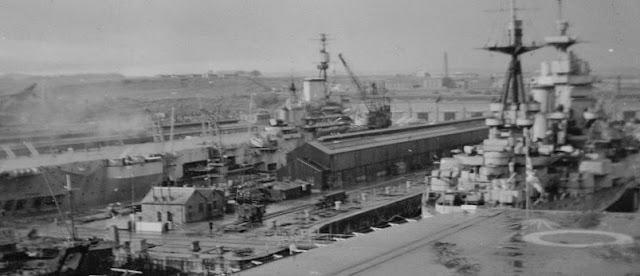9-Jun-43 Nelson arrived in Scapa Flow and Vice
Admiral Willis again raised his flag. She then went on to exercise with
battleships Rodney, Valiant and Warspite off Cape Wrath. The new radar system
improved the accuracy of the big guns fire such that all the towed targets were
destroyed in fifteen minutes and the shoot had to cease.
17-Jun-43 Exercises completed and crew back on
full war readiness Nelson sailed from Scapa with carrier Indomitable,
battleships Rodney Valiant and Warspite and destroyers Echo, Faulknor, Fury,
Inglefield, Intrepid, Offa, Panther, Pathfinder, Quail, Queenborough, Quilliam
and Polish vessel Piorun.
23-Jun-43 Group arrives in Gibraltar, after a very
rough passage, ready to take part in Operation Husky.
Landings for Operation
Husky, The Invasion of Sicily.
9-Jul-43 Nelson rendezvoused with 27 other
naval vessels to protect the convoys assembling for the start of Operation Husky.
The landings were to be in two main areas. The Western Force was to be all
American and the Eastern force, landing in the South East of Sicily was to be
British and Canadian. Nelson’s group were sent to the east to guide in the
convoys for the eastern landings and protect them from interruption by the
Italian Fleet. During the night of the 10th landings by American and
British paratroopers and glider forces took place. Strong winds meant that the
forces were scattered and delivered to the wrong places. However they did
disrupt the enemy arriving at the beaches and took some of their strategic
targets.
10-Jul-43 The Amphibious landings took place and
the strong winds caused delays and errors in navigation. Fortunately the enemy
thought that it would be too rough for landings to take place and so there was
very little opposition. At 0730 Nelson bombards Catania with her 16” guns then
patrols the Ionian Sea
13-Jul-43 Escort destroyers Echo and Ilex sink an
Italian Submarine.
14-Jul-43 Under air attack from Italian torpedo
bombers.
15-Jul-43 Nelson runs to Malta to refuel.
16-Jul-43 Leaves Malta to continue with patrols.
That evening the carrier Indomitable was torpedoed by a Ju-88 and Nelson
escorted her back to the safety of Malta. Following this she returned to her
patrols and later put inshore to bombard the port of Catania in support of
ground operations.
17-Jul-43 Nelson returns to Malta
Refueling HMS Ilex from HMS
Nelson.
20-Jul-43 Nelson was in Malta when a very heavy
air raid by 30 bombers caused severe damage and loss of life ashore. Shore
parties were sent out to assist. The evaporators aboard Nelson were playing up
and there was a severe shortage of water aboard. I expect that it got pretty
smelly aboard with the heat and 1756 crew in such a small space.
Most of August
was spent supporting the ground forces in action in Sicily. The main forces of
German and Italian troops evacuated the island by 17th August.
Between 27th and 29th Nelson was on exercise for
Operation Hammer, the bombardment of the coastal batteries North East of Reggio
di Calabria.
30-Aug-43 At 1900 Nelson left Malta in company with
Rodney, cruiser Orion and ten destroyers.
31-Aug-43 Firing was commenced at 1000 from
30000yds. Rodney opened fire at 1030. At 1200 all fire was stopped and the
targets were silenced permanently. By 2000 the force were all back in Malta.









